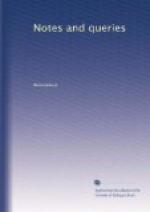North Side of Churchyards (Vol. ii., p. 253.).—In reference to the north region being “the devoted region of Satan and his hosts,” Milton seems to have recognised the doctrine when he says—
“At
last,
Far in the horizon to the north appear’d
From skirt to skirt a fiery region, stretched
In battailous aspect, and nearer view
Bristled with upright beams innumerable
Of rigid spears, and helmets throng’d,
and shields
Various, with boastful argument pourtray’d,
The banded powers of Satan hasting on
With furious expedition.”—Book
vi.
F.E.
Welsh Money (Vol. ii., p. 231.).—It is not known that the Welsh princes ever coined any money: none such has ever been discovered. If they ever coined any, it is almost impossible that it should all have disappeared.
GRIFFIN.
Wormwood (Vol. ii., pp. 249. 315.).—The French gourmands have two sorts of liqueur flavoured with wormwood; Creme d’Absinthe, and Vermouthe. In the Almanac des Gourmands there is a pretty account of the latter, called the coup d’apres. In the south of France, I think, they say it is the fashion to have a glass brought in towards the end of the repast by girls to refit the stomach.
C.B.
Puzzling Epitaph (Vol. ii., p. 311.).—J. BDN has, I think, not given this epitaph quite correctly. The following is as it appeared in the Times, 20th Sept., 1828 (copied from the Mirror). It is stated to be in a churchyard in Germany:—
“O quid tua te
be bis bia abit
ra ra ra
es
et in
ram ram ram
i i
Mox eris quod ego nunc.”
The reading is—
“O superbe quid superbis? tua superbia te superabit. Terra es et in terram ibis. Mox eris quod ego nunc.”
E.B. PRICE.
October 14. 1850.
[The first two lines of this epitaph, and many similar specimens of learned trifling, will be found in Les Bigarrures et Touches de Seigneur des Accords, cap. iii., autre Facons de Rebus, p. 35., ed. 1662.]
Umbrella (Vol. ii., pp. 25. 93.).—In the collection of pictures at Woburn Abbey is a full-length portrait of the beautiful Duchess of Bedford, who afterwards married the Earl of Jersey, painted about the year 1730. She is represented as attended by a black servant, who holds an open umbrella to shade her.
Cowper’s “Task,” published in 1784, twice mentions the umbrella:
“We bear our shades about us; self-deprived
Of other screen, the thin umbrella spread,
And range an Indian waste without a tree.”
Book
i.
In book iv., the description of the country girl, who dresses above her condition, concludes with the following lines—
“Expect her soon with footboy at
her heels,
No longer blushing for her awkward load,
Her train and her umbrella all her care.”




